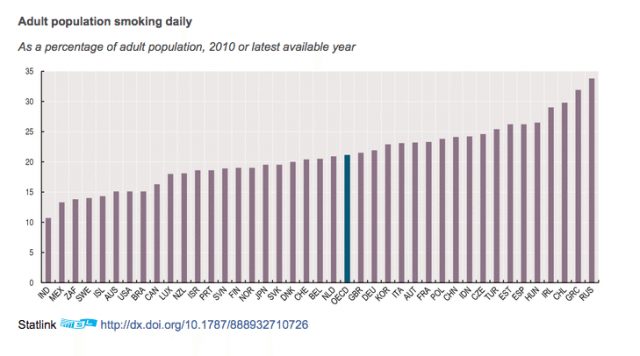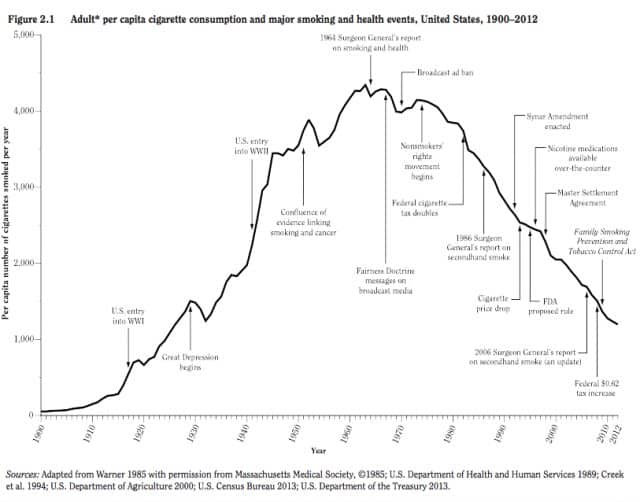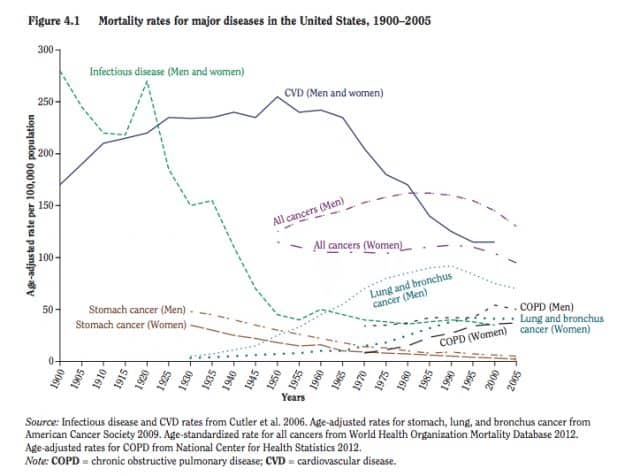The conversation between Don Draper and Sam, the waiter, in the first episode of the television series Mad Men is not only amusing but also has a deep message.
– Why do you smoke Old Gold, Draper asks.
– They gave ’em to us in the service… a carton a week for free.

– So you’re used to them is that it?
– Yeah. They’re a habit.
– I could never get you to try another brand… say, my Luckies.
– I love my Old Golds.
– Alright well, let’s just say tomorrow a tobacco weevil comes and eats every last Old Gold on the planet.
– That’s a sad story.
– A tragedy. Would you just stop smoking?
– I think I could find something. I love smoking. … My wife hates it. Reader’s Digest says it will kill you.
– Yeah, I heard about that.
– Ladies love their magazines, Sam chuckles.
Sam’s words illustrate a few important aspects of smoking. Firstly, there’s the strength of the addiction, the love, and the complete lack of interest to quit. Secondly, there’s the denial, the negligence of the risks: … “ladies just love their magazines.”
Smoke Gets in Your Eyes
The Mad Men television series is set primarily in the 1960’s. According to the show’s first episode, the phrase “Mad Men” was a slang term coined in the late 1950’s by advertisers on Madison Avenue to refer to themselves.
But what about the smoking. Why is cigarette smoking such an integral part of people’s lives in Mad Men? The figure below may provide some answers.
During the Second World War, there was a very steep increase in cigarette smoking in the USA. The top of the smoking mountain was reached in the sixties and since 1975 there has been a steady decline.
When Sam said; “They gave ’em to us in the service… a carton a week for free…” he was obviously referring to the First World War.
Cigarettes were given to US soldiers in the First World War, thereby creating a new generation of addicts. Of course, the government also found tobacco to be a great source of income that could be effectively taxed.
So, no wonder the pilot episode of Mad Men is called “Smoke Gets in Your Eyes”. It’s all about the cigarettes. The rooms are filled with smoke. It almost moves you to tears.
Prior to 1900, lung cancer was a rare occurrence with only 140 cases documented worldwide (1). As a result of the rapid growth of cigarette smoking, cancer rates rose explosively at the beginning of the twentieth century.
In the 1920s, German pathologists were among the first to recognize that cigarette smoking might be blamed for the rising incidence of lung cancer (2). By the 1930s, lung cancer had become the number two cause of cancer death among males in Germany, second only to stomach malignancies.
Nazi Germany was governed by a very health-conscious political elite (2). During his last years, Hitler himself followed a vegetarian diet (3) and did not smoke or drink.
Germany initiated the most powerful anti-smoking movement in the world during the 1930s and early 1940s. Research on smoking and its ill effects on health thrived under the Nazi government.
Interestingly, while the three most powerful fascist leaders of Europe (Franco, Mussolini, and Hitler) all abstained from tobacco, the three leading Allied leaders (Churchill, Roosevelt, and Stalin), were all heavy tobacco users (4).
Does Smoking Decide How We Die?
During the last decade, there have been substantial changes in disease patterns in the US and most other countries around the world. The figure below shows the death rates from selected major diseases across the twentieth century.
The sharp drop in mortality from infections is noticeable. The rising mortality from lung cancer is clearly evident with a decline starting around 1990. The mortality from cardiovascular disease reached a plateau in the 1960s and has been declining since then.
It is obvious that smoking has played a huge role in public health around the world for the last 100 years. Cigarette smoking causes 480.000 deaths in the US each year. Thus, nearly one in five deaths is caused by cigarette smoking (5).
Smoking is estimated to increase the risk of coronary heart disease and stroke by 2 to 4 times and lung cancer by 25 times.
Studies suggest that approximately 40 – 75 percent of the recent decline in mortality from cardiovascular disease is due to reductions in risk factors. The biggest achievement is believed to be due to reductions in blood cholesterol, smoking, systolic blood pressure and physical inactivity (6).
Many experts claim that lowering of blood cholesterol has played a major role in reducing the prevalence and mortality from coronary heart disease. Furthermore, they assume that cholesterol lowering has been achieved by reducing the amount of saturated fats and trans fat in our diet (7).
Other experts believe that changes in dietary fats simply cannot explain most of the reductions in blood cholesterol in most western countries (8). For example, although blood cholesterol dropped similarly in the USA and France between 1980 and 2000, changes in dietary fats explain only about 20% of the decline in the US and virtually none of that which occurred in France (9).
Lets’ look at the Japanese. The death rate from heart disease in Japan has been one-third to one-fifth that in the United States. Nonetheless, in Japan, the mortality rates from coronary heart disease declined 50% for men and 65% for women between 1969 and 1992. However, between 1980-2000 blood cholesterol increased significantly in both men and women (10).
In Japan, the prevalence of smoking declined from 82% in 1965 to 46% in 2005 for men and from 16% to 12% in women during the same period.
The decrease in cigarette smoking is probably the biggest factor behind the recent decline in death rates from heart disease and many types of cancer around the world.
Despite our ongoing efforts to damage our health with rising prevalence of obesity and type 2 diabetes, the death rate from cardiovascular disease is still declining, simply because we continue to smoke less.
Unfortunately, Hollywood and the film industry seems to be doing everything they can to glamorize smoking.
In youth-rated movies that showed any smoking, the average number of tobacco incidents per movie nearly doubled between 2002 and 2014 (11). It has been shown that watching movies that include smoking causes young people to start smoking. The more smoking young people see on screen, the more likely they are to start smoking.
Does the Devil Exist?
Despite the fact that smoking rates have declined rapidly in recent years, a substantial part of the world population still smokes.

So, smoking is still a huge public health problem around the world. The battle has not been won yet.
Unfortunately, the recent media frenzy on the obesity epidemic and the rising incidence of type 2 diabetes has taken up so much space that we almost forgot about smoking. The tobacco industry must be smiling.
The French poet, Charles Baudelaire said; “The greatest trick the Devil ever pulled was convincing the world he didn’t exist“.
Well, the tobacco industry is still alive and well. About the devil, I can’t tell.
Discover more from Doc's Opinion
Subscribe to get the latest posts sent to your email.



I have read others who believe the largest effect on CV death decrease is from decrease in smoking as well. Just think what might happen if everyone stopped eating carb laden foods!
This is an important blog post. I have 3 teenage grandkids. So far so good. None of them smoke. But I’ll link them all to your post.
What role did reductions in tailpipe emissions and reductions in pollution play in some of these outcomes if any?
Smoking is basically a very proximate form of air pollution. Though it is specific for lung cancer, it shares its atherogenic properties with many other airborne pollutants, and with other types of pollutants and some drugs.
If we look at the historical data that Axel cited, there are other dates that correspond with the decline in smoking and CVD; in particular, the mid-1950s were the time of the killer smogs and clean air legislation starts a few years later but takes a while to get going; 1963 was the year Silent Spring was published and reductions in athorogenic persistent pollutant exposure began soon after in the late-60s and early 1970s; and this timeline is true of America, Japan, and much of Europe.
The invention of the catalytic convertor is probably the critical point at which it became possible to radically clean up city air, but the spread of electric heating replacing coal and gas fires was a constant source of improvement before that and is still ongoing today.
To see the effects of this process in reverse, go to Beijing.
The author addresses the situation in Japan, yet indicates the facts are the opposite of the observed truth. Japan’s smoking rate both numerically and per capita, remains quite high, while the incidence of Lung cancer remains substantially lower than what is seen in other industrialized countries. With a huge population and less land to accommodate trucks and cars, the exposures to engine emissions is very low, in direct comparison. Cigarettes can be made safer by proven flu curing technologies that reduce both the most suspect carcinogens and histamines, by somewhere in the regions of 95% by simply removing exposure to diesel exhaust from the curing process. The 1933 German response invested in statistical propaganda, was not as well informed as we are today. The problem is that the theological “just rewards” enthusiasts need to keep alive the wages of sin,and the ideal that smokers deserve their fate. So all attempts to make cigarettes safer, will be challenged and shouted down enthusiastically by those who tell us they are ethical. The rants against electronic cigarettes with no tobacco and no combustion should expose the reality, of who is defining your world. Most don’t even realize, the same corporations who bring your news, get paid to sell it.